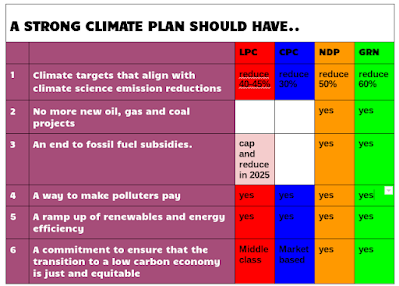NDC Commitments Canada
As Canadian Federal Election #44 comes closer, the policy of the political parties concerning meeting GHG reduction goals set by the IPCC needs to be examined and critically evaluated.
Stephanie Taylor of The Canadian Press reports to Global News that Conservative Leader Erin O’Toole rejects the Liberals’ higher emission reduction goal but vows to still meet the Paris target. O’Toole is facing criticism after rejecting Canada’s new target for reducing greenhouse gas emissions in favour of a lower one first set by Stephen Harper.
His pledge comes as Canada prepares to attend the United Nations Climate Change conference this fall where countries are expected to commit more ways to tackle the issue. In anticipation of the meeting, the Liberal government recently increased its targets for reducing greenhouse gas emissions to between 40 to 45 per cent below 2005 levels by 2030, up from 30 per cent. The 30 per cent goal was set by former Conservative prime minister Stephen Harper and was the commitment the country was held to under the 2015 Paris Agreement. O’Toole says the Conservatives’ climate change plan “will meet the Paris objectives” of 30 per cent, despite the United Nations specifying the agreement works by countries coming up with “increasingly ambitious climate action” every five years.1
Mitchell Beer has compiled a report in the The Energy Mix noting that Conservative Leader Erin O’Toole pledged to move boldly backwards on Canada’s emissions reduction target, and the fossil lobby has published its campaign wish list, and the climate crisis held its spot as a top concern for Canadian voters as the federal election moved into its third week.
Speaking in Newfoundland on Friday, Conservative Leader Erin O’Toole said he would jettison the Trudeau government’s international commitment to cut Canada’s greenhouse gas emissions 40 to 45% by 2030, and return to the Harper-era target of 30%, in search of a carbon target the country can achieve without “crippling” the economy.
If Canada were to [act on O’Toole’s promise], it would not violate an obligation, because the NDC itself is not legally binding,” University of Toronto law professor Jutta Brunnée explained. “But it would be contrary to the spirit of the Paris Agreement,” and “a challenge to the entire logic of the Paris Agreement, because the logic is progression over time. So it’s not something that one should take lightly.” New Democrats are campaigning on a 50% GHG reduction target by 2030, while the Green Party is talking about 60%..2
The fossil lobby has published its campaign wish list and CAPP President and CEO Tim McMillan says “To be resilient and sustainable, recovery will be a multi-year process based on robust economic activity.”
McMillan says continues “ It is crucially important for the incoming federal government to make policy decisions that position Canada for success in an ultra-competitive international investment market. Investment supports industry growth and is vital to developing and commercializing technologies that reduce emissions, water use, and more.” Cenovus Energy CEO Alex Pourbaix let it be known—apparently without a hint of irony—that he expects Canadian taxpayers to shell out up to C$52.5 billion to help his industry get the carbon out of its operations. “It’s going to take tens of billions of dollars over 30 years to decarbonize [our oil] industry,” Pourbaix said2
Angela Carter, associate professor of political science at the University of Waterloo, noted that climate was already a top priority in the 2019 election.
“But this year, there’s a difference.“ There is a growing awareness that the climate crisis is, of course, also a health crisis,” Carter told the CBC. “And we have leaders, international leaders, Mark Carney is one of these, at the United Nations who said that the climate crisis in 50 years is going to look like a COVID pandemic every single year.”2
Sussex Strategy Group Senior Counsel Shawn McCarthy says climate change will show up as a “wedge issue” on the campaign trail, even if it didn’t much look that way in the first two weeks.
Though Conservative Leader O’Toole has made an effort to close the gap between his party’s 2019 climate platform and its position today, there are still “yawning differences among the parties with regard to climate ambition,” McCarthy writes. “There continue to be deep cleavages in terms of how they would treat the oil and gas sector, which is responsible for 25% of Canada’s greenhouse gas (GHG) emissions.” While the Trudeau government is vulnerable on its continuing support for the fossil industry, not least its decision to buy the Trans Mountain pipeline with taxpayers’ dollars, O’Toole’s carbon target “is clearly insufficient to put the country on course for achieving net-zero status by 2050,” McCarthy says. “The Liberals will no doubt remind climate-conscious voters that the Conservatives have not endorsed the net-zero target.”.2
The commitment of the Government we elect on September 20 to aggressively cooperate with the industrial nations of the world to reduce GHG emissions is essential to mitigate the effects in storms, fires, biodiversity, and public health of the climate emergency.
References


No comments:
Post a Comment